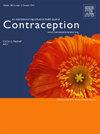医疗补助患者的远程医疗公平性
IF 2.3
2区 医学
Q1 OBSTETRICS & GYNECOLOGY
引用次数: 0
摘要
医疗保健目前占所有堕胎护理的20%,它被誉为一种通过使堕胎护理更加方便和负担得起来改善卫生公平的机制。然而,许多享受医疗补助的病人无法使用他们的保险来支付远程医疗堕胎的费用。我们试图记录和比较那些能够和不能使用医疗补助保险支付堕胎费用的患者的经历。方法:我们与美国六家为患者提供服务的远程医疗诊所合作,招募了远程医疗堕胎患者,他们表示他们有医疗补助保险,无论他们是否能够使用他们的保险,都参加了一项在线调查。如果患者参加了医疗补助计划,年龄至少14岁,在过去1-6周内进行过药物流产,并且英语或西班牙语流利,则符合条件。该调查以英语和西班牙语提供,并包含有关参与者人口统计、怀孕史和他们最近的远程保健堕胎经历的问题。结果在359名参与者中,约有一半(n=159)无法使用医疗补助保险来支付堕胎费用。这些人在堕胎护理上平均花费261美元(范围:0- 970美元)。那些没有医疗补助的人更有可能报告他们的财务压力比堕胎前更严重(35%比4%,p<0.001)。结论医疗补助覆盖对远程医疗流产也有影响,远程医疗流产是一种成本较低的流产选择。这些发现支持推翻远程医疗和医疗补助覆盖限制的努力,并建立远程医疗服务的覆盖和支付均等。本文章由计算机程序翻译,如有差异,请以英文原文为准。
TELEHEALTH EQUITY AMONG PATIENTS WITH MEDICAID
Objectives
Telehealth, which now comprises 20% of all abortion care, has been celebrated as a mechanism to improve health equity by making abortion care more convenient and affordable. However, many patients with Medicaid are not able to use their insurance to pay for their telehealth abortion. We sought to document and compare patient experiences between those who could and could not use their Medicaid insurance to pay for their abortion.
Methods
Working with six telehealth clinics serving patients across the US, we recruited telehealth abortion patients who indicated they had Medicaid insurance, regardless of whether they were able to use their insurance, to participate in an online survey. Patients were eligible if they were enrolled in Medicaid, were at least 14 years old, had had a medication abortion within the last 1-6 weeks, and were fluent in English or Spanish. The survey was available in English and Spanish and contained questions about participant demographics, pregnancy history, and their recent telehealth abortion experience.
Results
Among 359 enrolled participants, about half (n=159) could not use their Medicaid insurance to cover their abortion. Those in this group spent an average of $261 for their abortion care (range: $0-$970). Those with no Medicaid coverage were significantly more likely to report that their financial stress was worse than before the abortion (35% vs. 4%, p<0.001).
Conclusions
Medicaid coverage makes a difference even for telehealth abortion, which is a less costly abortion option. These findings support efforts to overturn telehealth and Medicaid coverage restrictions, and establish coverage and payment parity for telehealth services.
求助全文
通过发布文献求助,成功后即可免费获取论文全文。
去求助
来源期刊

Contraception
医学-妇产科学
CiteScore
4.70
自引率
17.20%
发文量
211
审稿时长
69 days
期刊介绍:
Contraception has an open access mirror journal Contraception: X, sharing the same aims and scope, editorial team, submission system and rigorous peer review.
The journal Contraception wishes to advance reproductive health through the rapid publication of the best and most interesting new scholarship regarding contraception and related fields such as abortion. The journal welcomes manuscripts from investigators working in the laboratory, clinical and social sciences, as well as public health and health professions education.
 求助内容:
求助内容: 应助结果提醒方式:
应助结果提醒方式:


